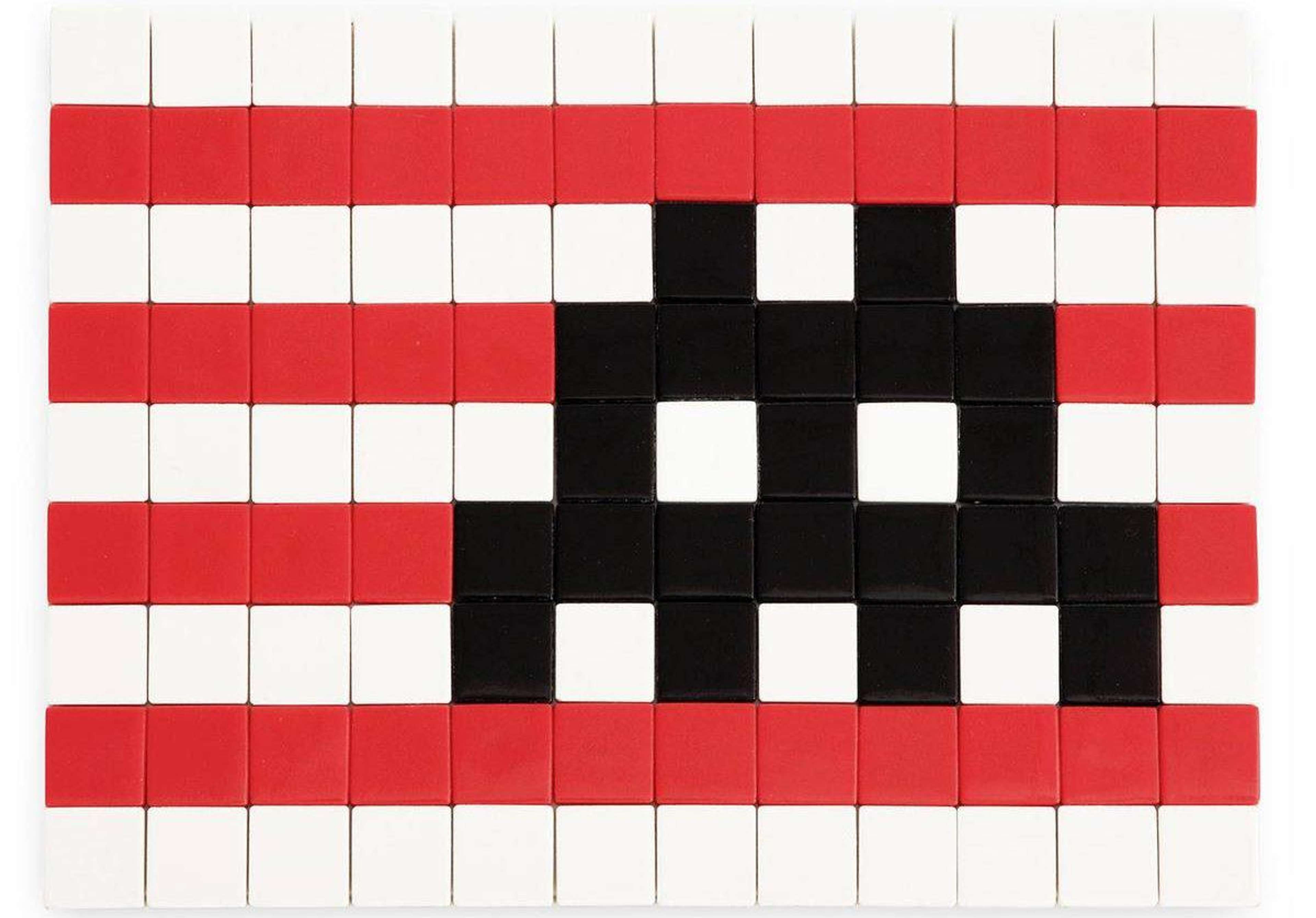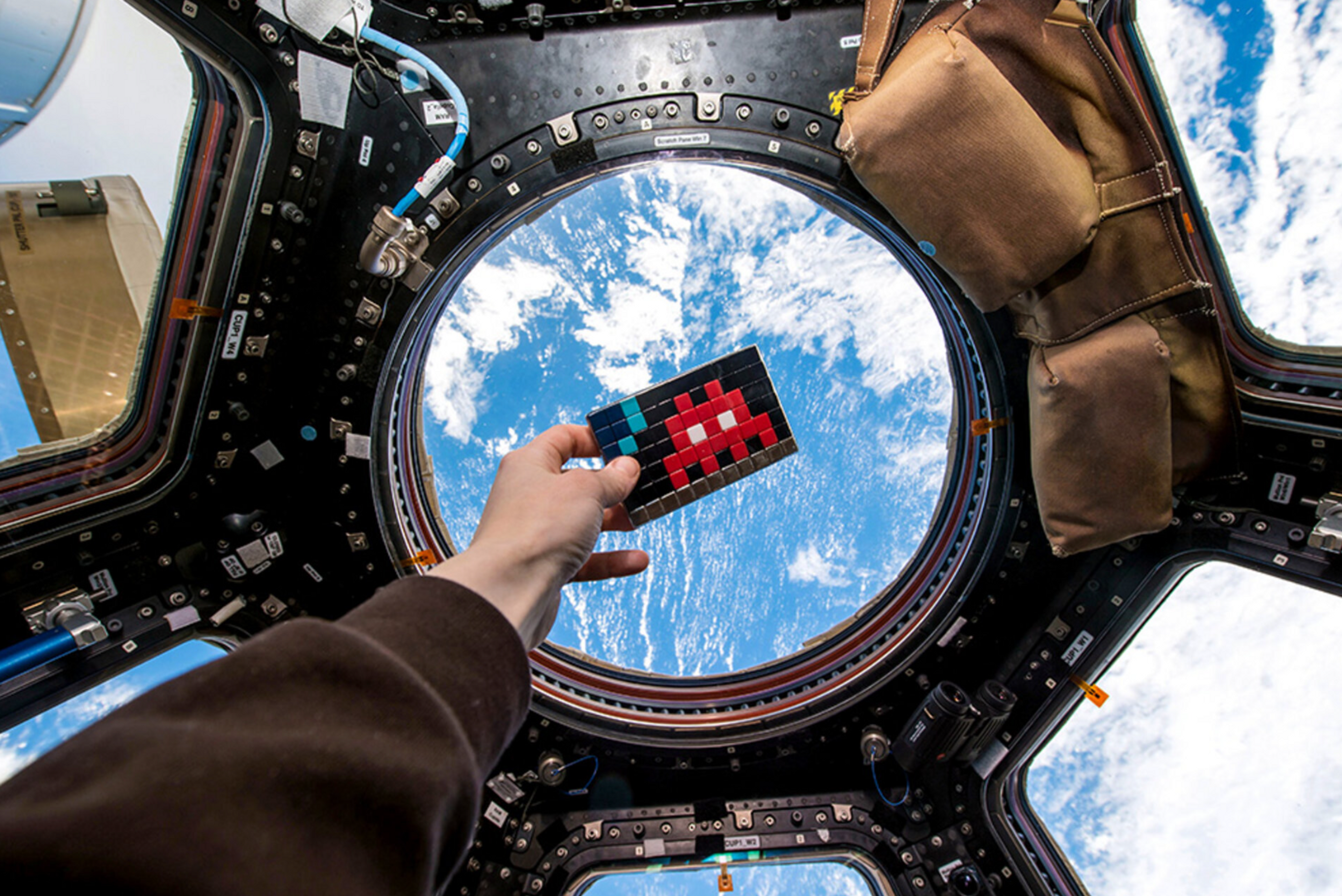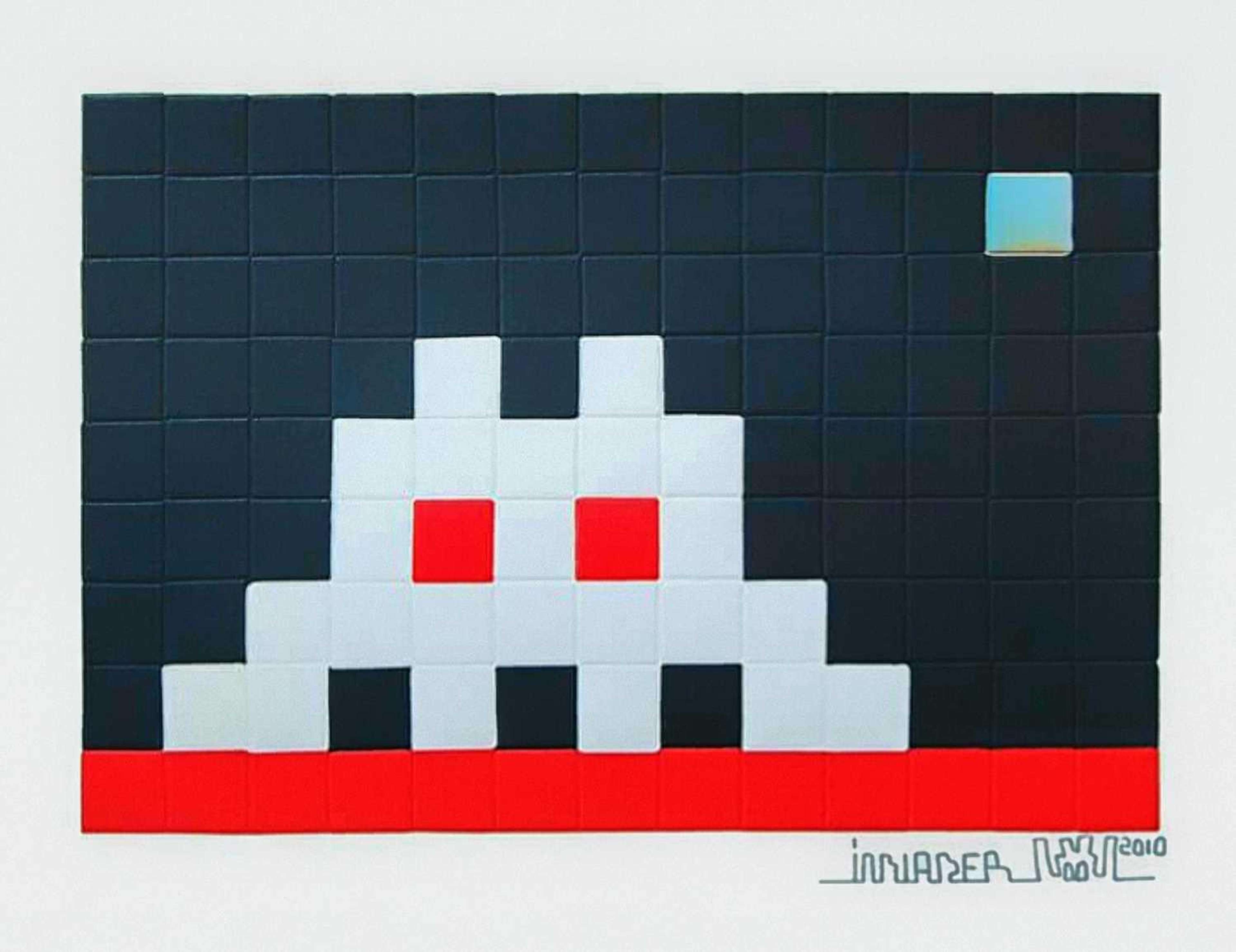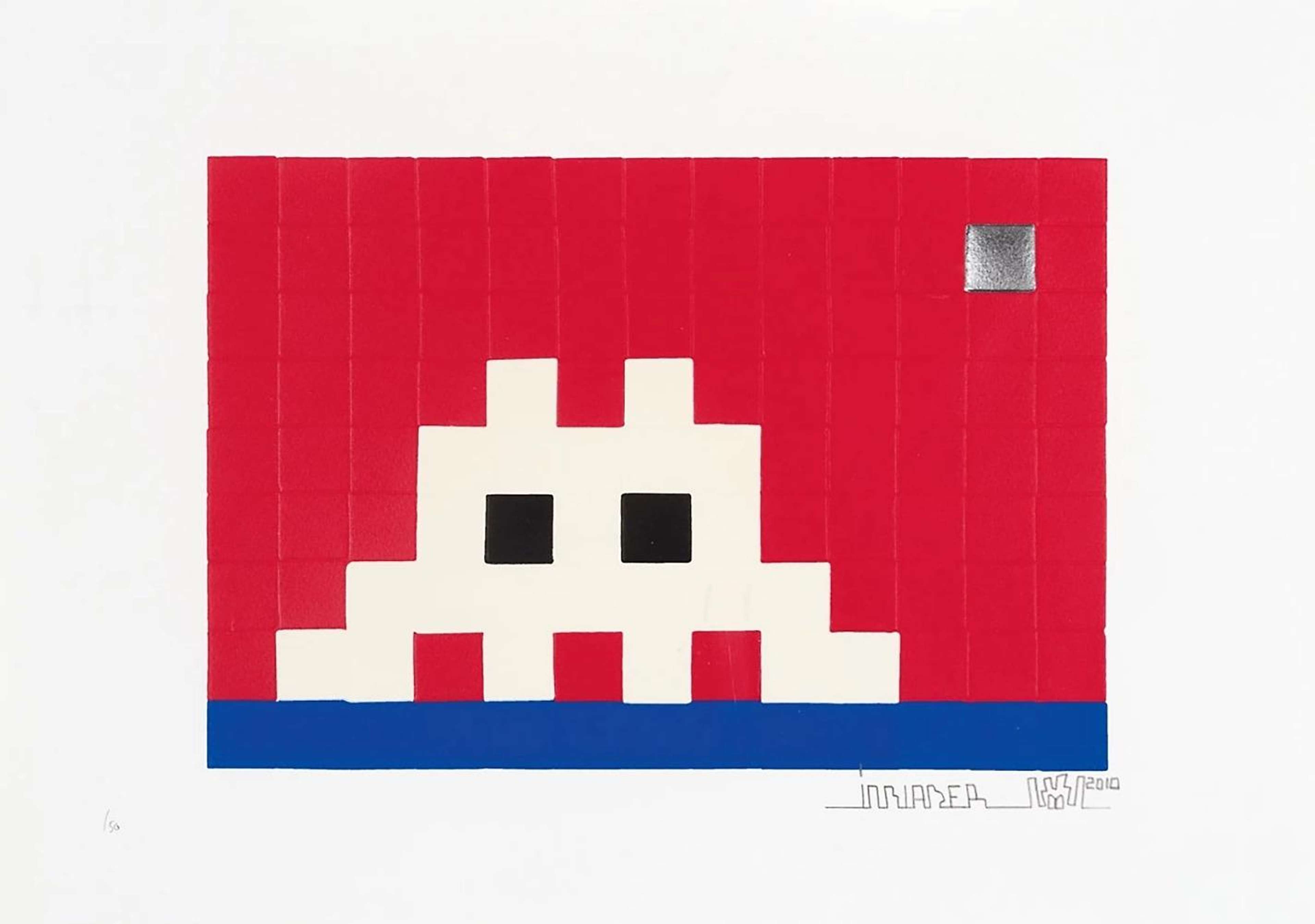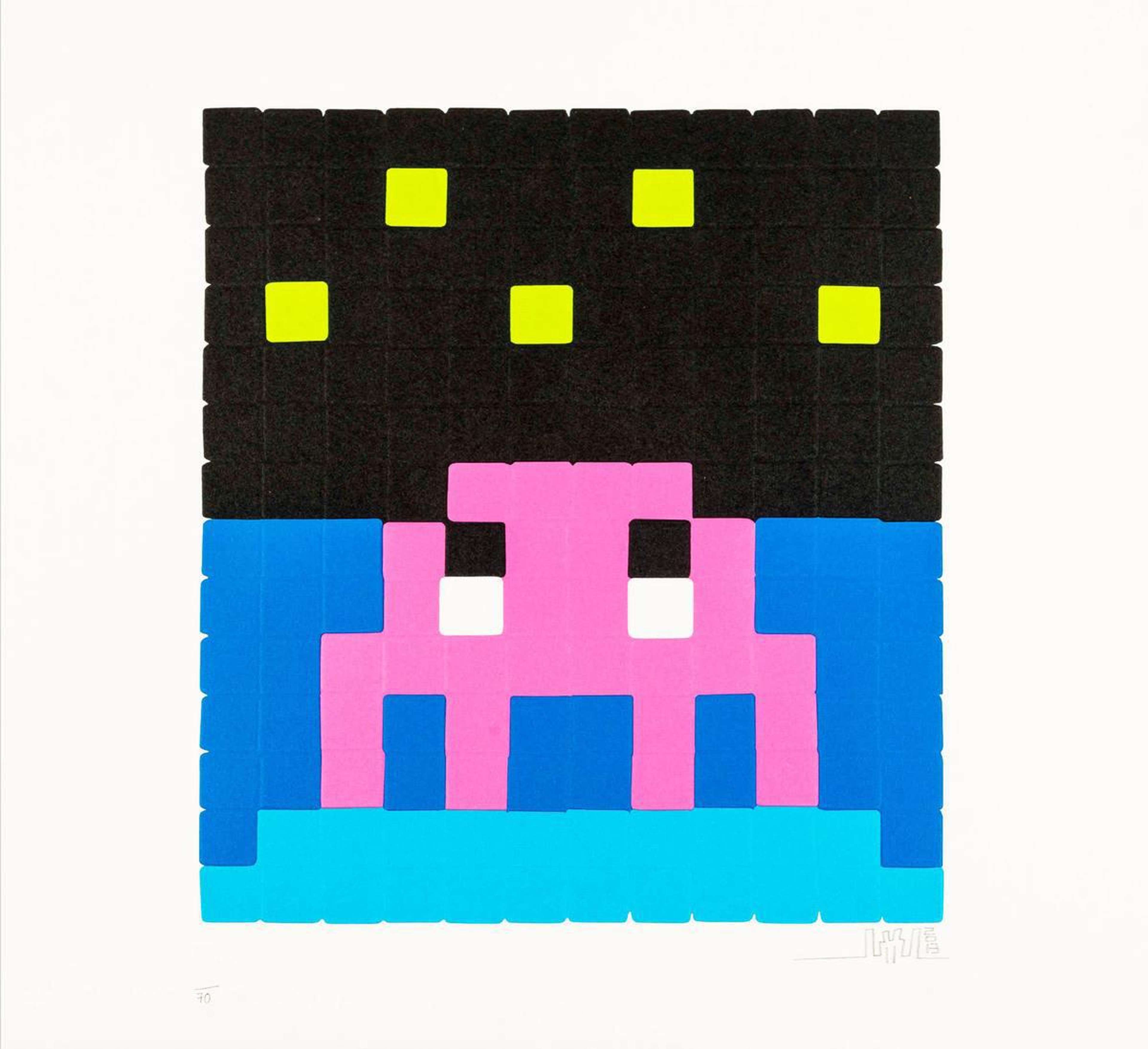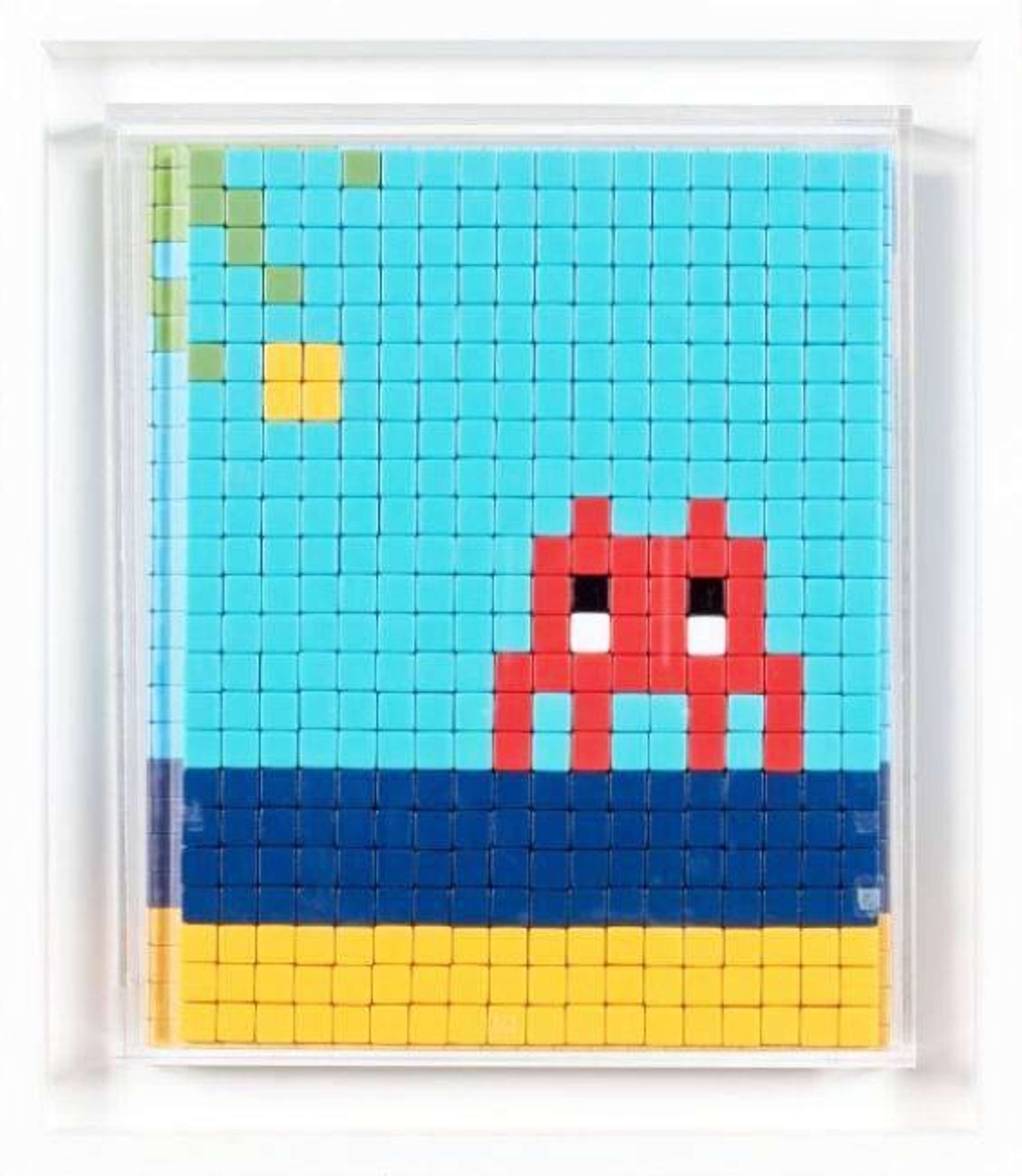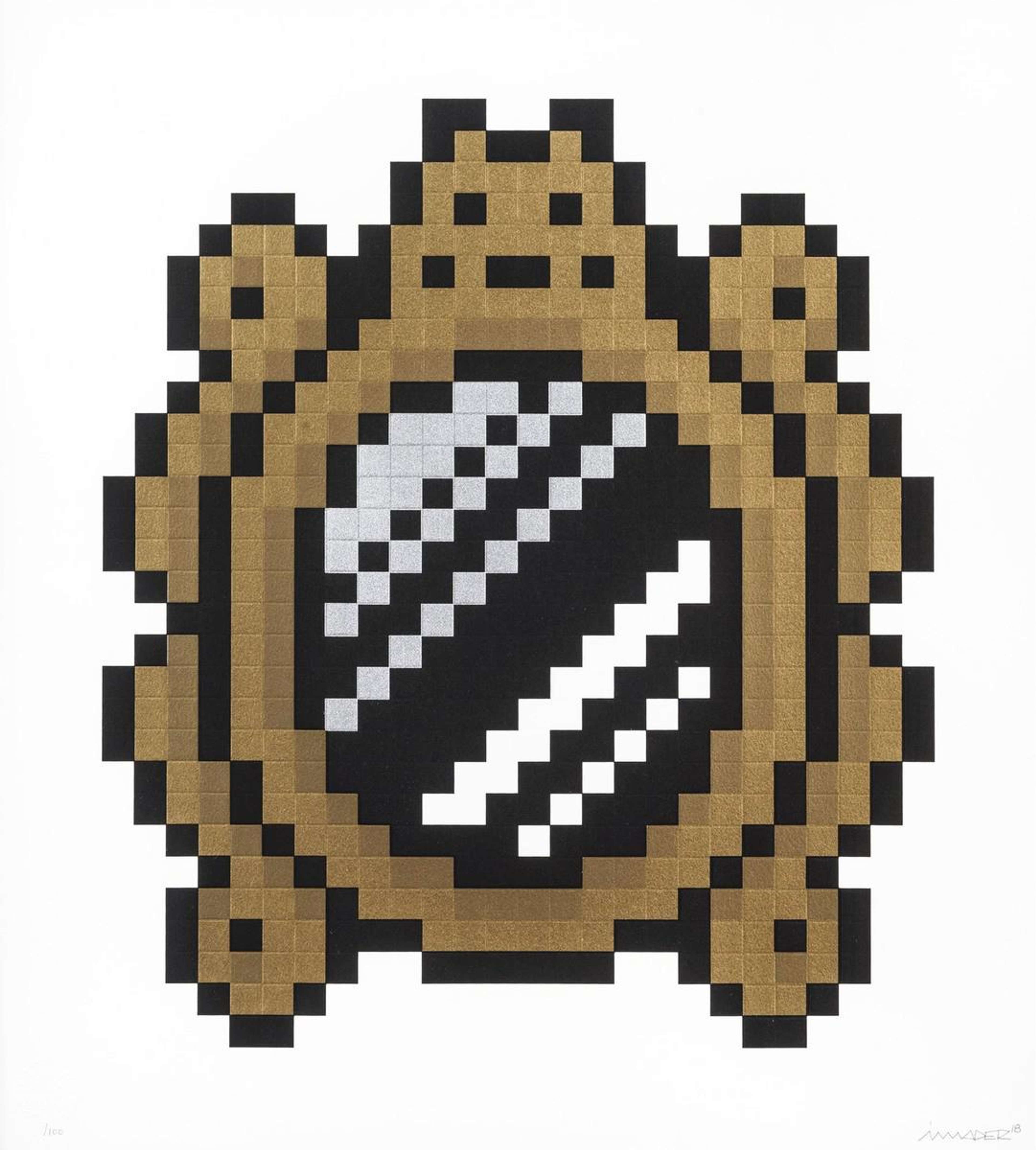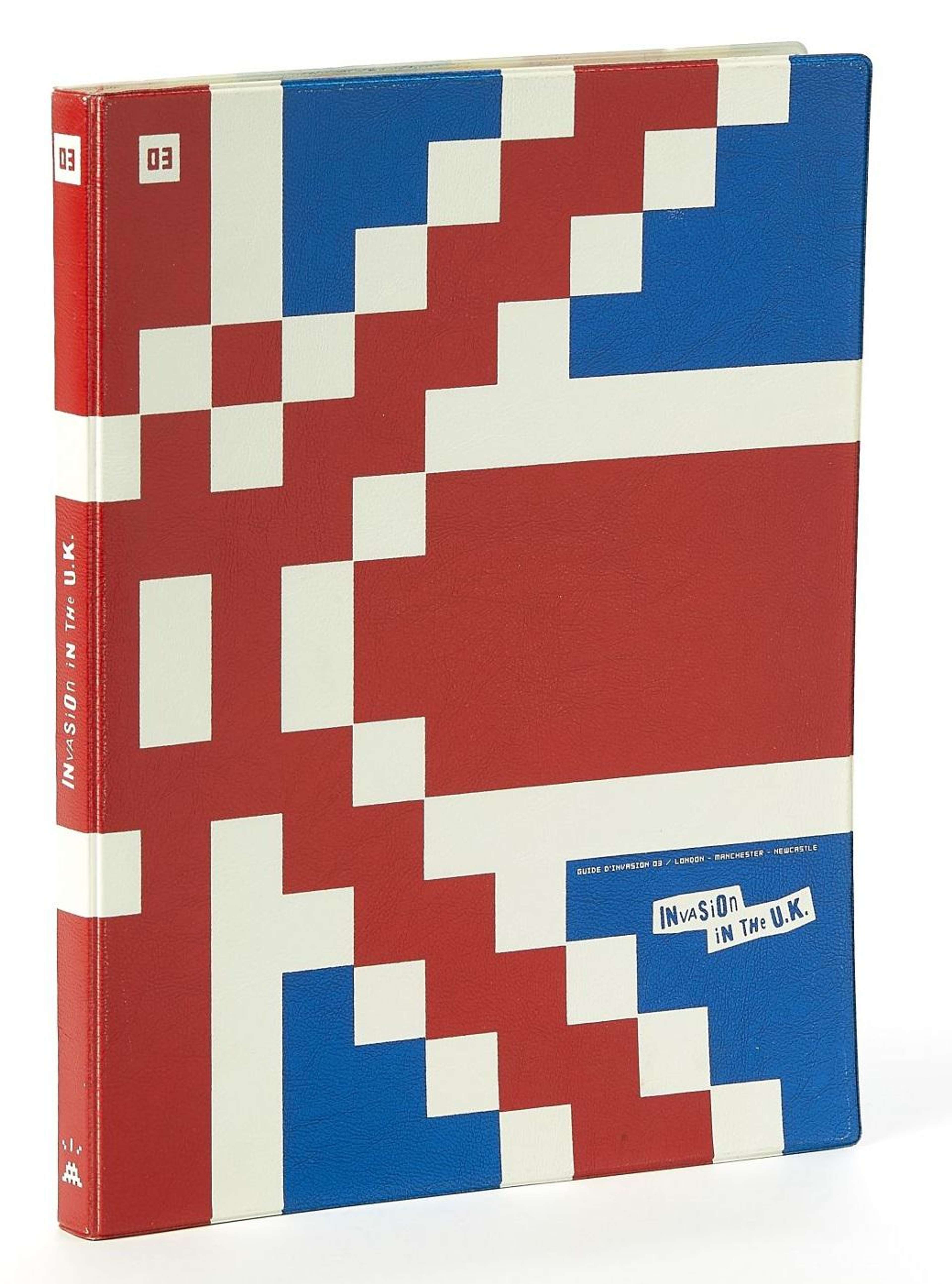 Invasion Kit 4, Rubik Space © Invader 2004
Invasion Kit 4, Rubik Space © Invader 2004
Invader
111 works
After some Invader artist facts? The elusive French street artist is difficult to pin down. From his involvement with Banksy through to his missions into outer space, here is our A-Z of one of the most influential street artists of our time.
A is for Aladdin Sane
An homage to musician David Bowie, Invader’s Aladdin Sane series transposes the iconic cover artwork of Bowie’s 6th album onto the faces of the Ghost Gang — characters from the world-famous arcade game Pac-Man.
Why Bowie, you ask? Well, they’re both intergalactic artists, of sorts. Plus, the phrase ‘space invader’ features in the lyrics of the singer’s Moonage Daydream — part of the seminal Ziggy Stardust (1972) album.
B is for Banksy
Or, more precisely, Banksy’s self-directed documentary film Exit Through The Gift Shop (2010).
In the film, Thierry Guetta – aka Mr. Brainwash – follows Invader around the streets of Paris at night, filming him as he erects his mosaics in the city’s Marais quarter. Later in the film, Invader is seen affixing one of his pieces to the ‘D’ of the iconic Hollywood sign in Los Angeles.
Many have interpreted the film as a complex publicity stunt or feature-length critique of how art has become little more than a material commodity in recent years. Others have dubbed the film a piece of conceptual art in its own right.
C is for Clockwork Orange
Together with The Shining (1980), the seminal 1971 film A Clockwork Orange was the basis of one of two mosaic tributes to legendary film director Stanley Kubrik.
Dubbed Rubik Kubriks, the works are part of the larger series, entitled Rubikcubism.
D is for Djerba
In 2019, Invader staged a large-scale ‘invasion’ of the Tunisian island of Djerba. With the help of two assistants — known only as ‘Mr. Blue’ and ‘Mr. Yellow,’ the artist installed over 58 mosaics across the island.
Commenting on his trip, Invader remarked that he had never put up so many pieces in broad daylight before.
E is for École des Beaux-arts
Although little is known about Invader’s true identity, there is one thing we can be sure about: he is a graduate of Paris’s prestigious École des Beaux-arts art school.
In April of 1874, a group of artists defied the traditional approaches of the Paris Salon — an annual art event organised by what became the École des Beaux-Arts — by setting up their own independent exhibition.
With this exhibition, this group of artists — which included Camille Pissarro, Edgar Degas, Auguste Renoir, and Claude Monet — birthed Impressionism.
F is for France
Invader has carried out the highest number of full-scale ‘invasions’ in his home country of France.
Hitting up cities including Toulouse, Marseille, Lille, Nantes, Lyon, and Perpignan, he has left little of the country untouched.
You can see the exact locations of each of Invader’s ‘Invasions’ in the artist’s Invasion Guides, or on the ‘World Invasion’ page.
G is for Graffiti
Graffiti has been a central influence in the lives and creative practices of many artists, like Keith Haring, Jean-Michel Basquiat, and Banksy.
But can we say that Invader is influenced by graffiti? There’s certainly no spray can in sight.
Well, yes. Despite his use of non-traditional materials, Invader deems graffiti an instrumental force in his creative process.
When once asked whether his mosaic productions are contemporary art, a game, graffiti, or street art, Invader casually replied: ‘All of the above, and much more.’
H is for H.G Wells
At the heart of Invader’s œuvre are a series of ‘alien’ characters, taken from Tomohiro Nishikado’s world-famous arcade game, Space Invaders.
These characters, though, were based on those drawn by science fiction author H.G. Wells as an accompaniment to his seminal 1898 novel, War of the Worlds.
I is for Invasions
This is what Invader dubs his artistic interventions.
He explains: ‘Little by little, I organised a detailed process by which I explore international densely populated urban areas and "invade" them. Usually, I try to display 20 to 50 pieces per city, which is already a good score.’
‘Sometimes I happen to return several times in the same city, deploying different “invasion waves” as I like to call them. The goal is to increase my score by continuously and restlessly invading new spaces.’
J is for Japan
Whether Invader’s true origins are in the French capital or in outer space, his art is indebted to one far eastern country: Japan.
In 1978, Osaka-born designer Tomohiro Nishikado created an iconic arcade game that would go on to change the gaming and design worlds forever.
Named Space Invaders, it was an overnight success, selling thousands and thousands of copies by 1982.
The initial inspiration for Invader’s name and pixelated visual style, without Space Invaders – and Japan – there would be no Invader. The artist even says so himself: ‘It was the first step towards the digital, the first video game, from which everything else followed.’
K is for Kung Fu
In 2015, Invader issued a signed limited edition screen print. Its subject matter? The Kung Fu Kick.
A rare example of Invader’s figurative works, the piece portrays a figure launching a flying front kick at their opponent. It takes inspiration from the 1984 video game, Kung-fu Master, known as Spartan X in Japan.
L is for Leonardo da Vinci
Invader doesn’t target streets alone: art history is also prime territory for his ‘invasions’.
In works like Low Res Mona (2014), Invader takes aim at art historical canon in the form of Leonardo da Vinci’s world-famous painting, Gioconda – otherwise known as the Mona Lisa.
An 8-bit view of what is perhaps the most famous painting in the world, the work is executed in a style Invader has dubbed ‘Rubik’s Cubism’.
M is for Mosaics
With their origins in Mesopotamia – an area spanning modern-day Iraq – mosaics are the cornerstone of Invader’s artwork.
The perfect medium for recreating the rudimentary graphics of early arcade games, mosaics place Invader in an artistic tradition that began as early as the 3rd millennium BC.
In tribute to the humble coloured tile, in 2014 and 2016 the artist carried out ‘invasions’ of Ravenna – an Italian city famed for its intricate mosaics.
N is for 'Not Always'
When asked whether he ever has issues with the police, Invader responded with exactly these words: ‘Not always’.
Although banned from several countries due to his art, some police officers allegedly refrain from prosecuting him.
As fans of Invader, they turn a blind to him sticking his tiles on private property, allowing him to continue with his ‘invasion’ of the city and its streets.
O is for Original
Since 1998, when Invader began working, a number of people have begun to use tiles and mosaics to create artworks in the street.
But despite their stepping on his toes, Invader will always be the indisputable king of the mosaic – and the most recognisable artist working with this material.
His auction prices - which can reach record prices of up to 7-figure sums - confirm his standing in the world of contemporary art.
P is for Paris
Invader’s hometown and site of the highest concentration so-called invasions.
Part of the Maps collection, Invasion de Paris (2011) is a signed lithograph print showing the exact locations of some of Invader’s more recent installations in the city of lights.
Q is for Quotes
Despite his mysterious, evasive nature, Invader is full of pithy quotes about his unique artistic practice.
Commenting on his choice of — the Space Invader — Invader once remarked: ‘As these creatures are made of pixels they are in some sorts ready-made for tile reproduction […] their names are literally predestined for the project I have pioneered: they are ‘Space Invaders!’.
R is for Real Name
What is Invader’s real name?
Well, there is much speculation that the world’s only UFA — or Unidentified Free Artist — is actually named Franck Slama.
Known for wearing a mask in public, few people can claim to have seen his face, however.
So, for now at least, we’re still in the dark.
S is for Space
Since 2012, Invader has installed two of his works in outer space as part of the Art4Space project.
In 2012, with the help of a high-altitude balloon, Invader launched one of his artworks – Space 1 – into the stratosphere: the middle layer of the atmosphere, located some 60km from the earth’s surface.
Later, in 2014, a new artwork made it all the way to the International Space Station, where it was put on display by Italian astronaut, Samantha Cristoforetti.
T is for Tk_119
A visual tribute to iconic Japanese manga series Astro Boy, Tk_119 (2014) is the most expensive Invader artwork to-date.
Going under the hammer at Sotheby’s New York in November 2019, it realised a total of US$1.2 million.
U is for Under The Sea
Invader’s artwork has not only made it to the outer reaches of the earths’ atmosphere — some of his pieces grace the bottom of the Caribbean Sea, off the west coast of Mexico.
In 2012, Invader collaborated with British artist and environmentalist Jason deCaires Taylor to realise his ambition of placing artworks in the ocean.
V is for Versailles
In 2018, Invader released signed screen prints as part of the Versailles series.
Evoking the baroque grandeur of the onetime residence of French Kings, the Palace of Versailles, the series comprises pixelated depictions of gilded mirrors in two colourways: black and blue.
W is for Worldwide
Invader has ‘invaded’ over 80 cities all over the world.
Erecting works in situ on the streets of locations like Vienna, Miami, Los Angeles, London, Manchester, and Newcastle, during each visit Invader aims to put up around 50 individual mosaics.
To do this, he uses special heavy-duty adhesive in the hope that thieves won’t attempt to remove the artworks and sell them on.
X is for Invader (X) PETA
In December 2020, Invader launched a limited collection of t-shirts and stickers in collaboration with PETA France. Supporting animal rights, the t-shirts were emblazoned with the slogans, ‘Freedom for All’ and ‘We Come in Peace, We Don’t Eat Flesh!’.
The sleeve of 12 stickers proved particularly popular, selling out within the first three hours of going on sale.
Y is for Years
Invader has been working since 1998. With almost 25 years in the business, he often tells interviews that he was trained at a tiling school on the planet Mars.
Z is for Zodiac
Born 2nd May 1969, Invader is a Taurus. The earth sign is known for having a strong desire for extravagance while being reliable and down-to-earth, something Invader embodies in his eccentric street art invasions that connect with a broad audience.
Browse our Invader prints for sale or get a valuation here.



